Popular Zadar Kolovare Beach to Get Makeover Before 2021 Season
April the 5th, 2021 - The popular Zadar Kolovare beach is set to get a brand new look before the arrival of the 2021 summer tourist season.
Although summer 2021 remains in question in the sense of what sort of touristic results Croatia might manage to achieve given the continued poor epidemiological picture across not only the country but within Europe as a whole, accompanied by a very poor, slow vaccination rollout across the majority of the continent with the exception of the United Kingdom - the extremely popular Zadar Kolovare beach will still get a proverbial face-lift.
Zadar never fails to attract tourists from all over Europe and indeed from the rest of the world with its beauty, history and abundance of culture. Those sunsets which were once described by the legendary British film director and producer Alfred Hitchcock as the most beautiful in the world also lend a helping hand. Despite all of the above, this historic Dalmatian city has suffered the same fate as the rest of the Croatian coast as tourist numbers plummeted during pandemic-dominated 2020.
With hopes for summer 2021 higher, regardless of the current unfavourable situation related to the spread of the novel coronavirus, the Zadar Kolovare beach will get some brand new outlines/contours and take on what is being referred to as a totally different look as fingers remain cautiously crossed for summer 2021 and the arrival of foreign tourists once again.
As Morski writes, amid the coronavirus pandemic back in October 2020, the works on the Zadar Kolovare beach began. Those works were long-awaited and things got off to a good start in the part of the beach between the swimming pool and the former restaurant located there.
Upon completion of the works, the local authorities have since announced, Kolovare will have a totally new appearance and a new lease of life despite the circumstances then and now.
The works are continuing in full swing and by the time things are finished up and polished off, the Zadar Kolovare beach will have completely new outlines and an updated look for visitors in summer 2021.
For much more on all you need to know about the City of Zadar, make sure to visit Total Croatia's Zadar in a Page.
Turks Turning Old Zadar Maraska Building into High Category Hotel
February the 18th, 2021 - The old Zadar Maraska building which is well known all over Dalmatia and the rest of the country for its representation of 500 years of tradition is soon to become a high category hotel, with construction beginning this autumn.
As Morski writes, Zadar Mayor Branko Dukic recently met with the President and Chief Executive Officer of the Turkish Dogus Group Ferit F. Sahenko and his associates. The topic of conversation was the announcement of a new cycle of Dogus Group investments in the Dalmatian city of Zadar.
The Dogus Group is well known across Croatia for its numerous previous investments, and the conversion of the old Zadar Maraska building is sure to be a topic of conversation over the coming months.
''We're close to a partnership with a strong Croatian partner. We're planning to start the first phase of the hotel's construction in the autumn of this year. We're also finalising the blueprints for the living space around the hotel. We were pleased to be able to inform Mayor Branko Dukic about the further phases of the Maraska project,'' said the regional director of Dogus Croatia, Burak Baykan.
In addition to exchanging information on current projects for the development of Zadar's tourist offer and new business opportunities, the Mayor of Zadar expressed satisfaction with the announcement of the imminent start of construction of what will become highest category hotel in Zadar when completed.
''The City of Zadar, as an extremely tourist-oriented coastal city, urgently needs hotel accommodation of the highest category. I'm looking forward to the start of work on the future hotel in the old Zadar Maraska building beginning, which will confirm the correctness of the previous efforts of our city administration to attract new investments in the field of tourism, of which, I'm convinced, will be more and more.
We must continue to invest in our infrastructure, beaches, sport and recreational facilities, the restoration of cultural attractions and everything that will lead us raise the overall quality we can boast of and expand our range of destination products. All these efforts will contribute to the reduction of seasonality and create more new jobs. Zadar lacks accommodation in high category hotels and all investors whose projects can raise the value of Zadar's tourist product are ver welcome. The coronavirus pandemic will pass, people will start travelling again and it's up to us to welcome it and be read,'' Dukic concluded.
For the latest travel info, bookmark our main travel info article, which is updated daily.
Read the Croatian Travel Update in your language - now available in 24 languages.
VIDEO: Stunning Aerial Footage of Dolphin Family in Zadar Archipelago
February 1, 2021 – The Adriatic might be too cold for us right now, but conditions are perfect for this dolphin family, spectacularly captured gliding through glacial, undisturbed waters by an overhead drone
The Adriatic might be too cold for us right now, but conditions are perfect for this dolphin family, spectacularly captured gliding through glacial, undisturbed waters by an overhead drone
The footage of the dolphin family was captured spectacularly by keen amateur drone photographer Davor Miljkovic. Davor, who is from Zapresic, usually puts his eye for aesthetics into website design – he works as a PHP website developer for Virtus dizajn in Lanište, Zagreb and as a freelance website developer. But, he is currently taking advantage of working remotely and was able to catch footage of the dolphin family during his off time.
“I live in Zapresic but my grandmother is from island Rava, near Zadar,” Davor told TCN on 1st February 2021, two days after he posted the video of the dolphin family to his Youtube channel. “So, we have a house here by the sea. My fiance and I spend part of the winter here and we are here all summer too.”
The Zadar archipelago (in Croatian Zadarski arhipelag) is an incredibly picturesque group of islands off the coast of the city of Zadar. In addition to island Rava, off which Davor saw the dolphin family, the archipelago also consists of the islands Dugi Otok, Galešnjak, Iž, Lavdara, Ošljak, Pašman, Rivanj, Sestrunj, Tun Veli, Ugljan, Vir, Vrgada, Zečevo and Zverinac.
The beautiful stretch of islands is usually very popular with summertime visitors. It would seem that it's also popular in wintertime with visitors who live in the sea. And, of course, people like Davor who are lucky enough to catch sight of them.
For the latest travel info, bookmark our main travel info article, which is updated daily.
Read the Croatian Travel Update in your language - now available in 24 languages
First Zadar Street Food Festival to Enhance Postseason Offer
September 22, 2020 - The first-ever Zadar Street Food Festival will kick off at the end of the month to enhance the destination for both tourists and locals.
HRTurizam reports that gastronomy trends have recently turned to street food, so following that direction, the city of Zadar will launch its first Zadar Street Food Festival, which will be held from September 30 to October 4, 2020, at the Bamboo beach bar.
While the coronavirus epidemic has dictated how we hold outdoor gatherings, the end of summer is an ideal time for outdoor festivals. In addition to quality content for tourists, they also raise the quality of life for the local population.
Thus, at one of the most beautiful locations in Zadar, Puntamika, with a packed music program composed of local DJs, guests will enjoy simple but top quality dishes prepared by Zadar caterers.
Visitors will be able to try street food specialties directed by Hedonista, OX meet & eat, Maguro restaurant & sushi bar, Delimaris Fish & chips, Salsa Rosse, Burgers & More, and PIK GRILL HOUSE. Every visitor will find something tasty that suits them, from various types of gourmet burgers to fish and meat delicacies, special Pinsa pizza, and more.
The organizers also made sure there is something to satisfy the sweet teeth in the crowd. Led by Cafe Danica, guests can refresh with Italian ice cream, and Bamboo Ice will offer a varied selection of pancakes. There will also be cocktails and the opportunity for guests to taste local wines from the Zadar County area.
Street food festivals are a unique gastronomic and urban experience, and the city of Zadar is certainly on the list of urban cities with a quality offer outside the tourist season. As we all know, events and congresses are great as a motive for arrivals in the extension of the tourist season.
HRTurizam writes that this festival is a great time for hotels and other accommodation providers to get involved. Because this is great quality content for guests, be sure to inform them about the Zadar Street Food Festival, tell them the story of Zadar and the gastro scene, about Zadar Maraschino, and offer transport to the festival if possible.
If all goes well, the Zadar Street Food Festival, although conceptually created as a result of the coronavirus lockdown, will become a traditional event and a quality offer of Zadar.
Find out more about the Zadar Street Food Festival HERE.
For the latest travel info, bookmark our main travel info article, which is updated daily.
Read the Croatian Travel Update in your language - now available in 24 languages
Beautiful 3D Maps of Croatia, its Islands and the Adriatic
Sunday, 6 September 2020 – Fafarikula from Zadar creates beautiful bespoke 3D Maps of Croatia, its islands, the Adriatic, and the world. Made from wood, they're the perfect souvenir to take from the coast
A stay on the Croatian coast is full of one-off experiences. Each island is unique, every wine and sunset is different. The same cannot be said for some of the mass-produced souvenirs available.
But, one small Zadar company has created a wonderful alternative to plastic keyrings and ill-fitting slogan t-shirts. Fafarikula makes beautiful 3D maps of Croatia, its islands, and the Adriatic. Made from wood and available to order, they can hang in your home and remind you every day of your trip to the Croatian sea.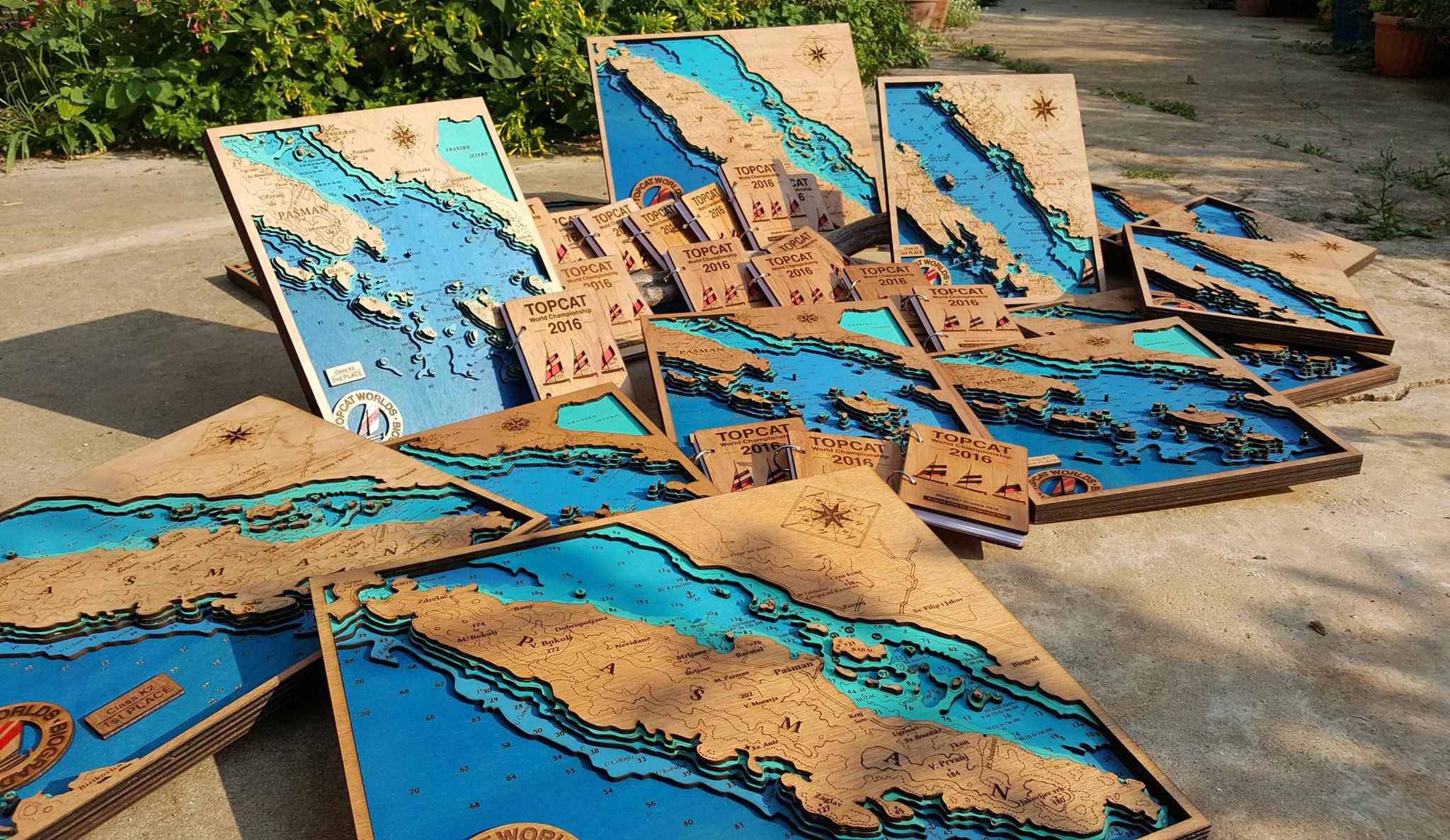
The 3D maps of Croatia are made using a laser cutter and depict an accurate representation of shorelines and sea depths. Five layers of wood are used in their construction, then fixed atop one another.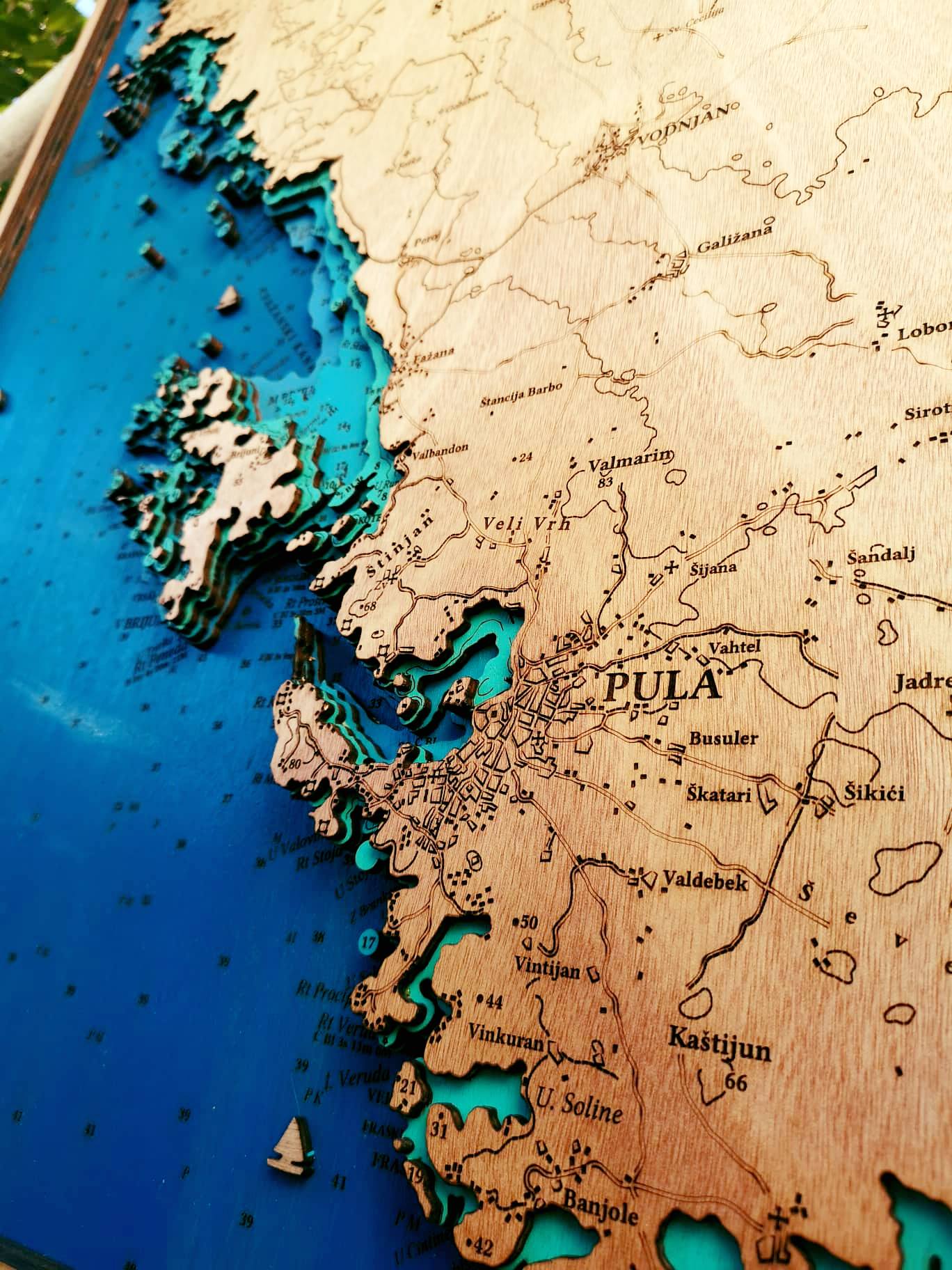
Ida Šimunov and Marko Rihelj are the couple behind the 3D maps of Croatia. They founded their quality souvenir company, Fafarikula five years ago. They have a range of maps already available, but if you've fallen in love with one particular destination, they can make a bespoke map just for you. In addition to the 3D maps of Croatia, the company has recently produced maps of the Mediterranean and the whole world. They also make wood-bound notebooks, pendants, and a huge variety of fridge magnets.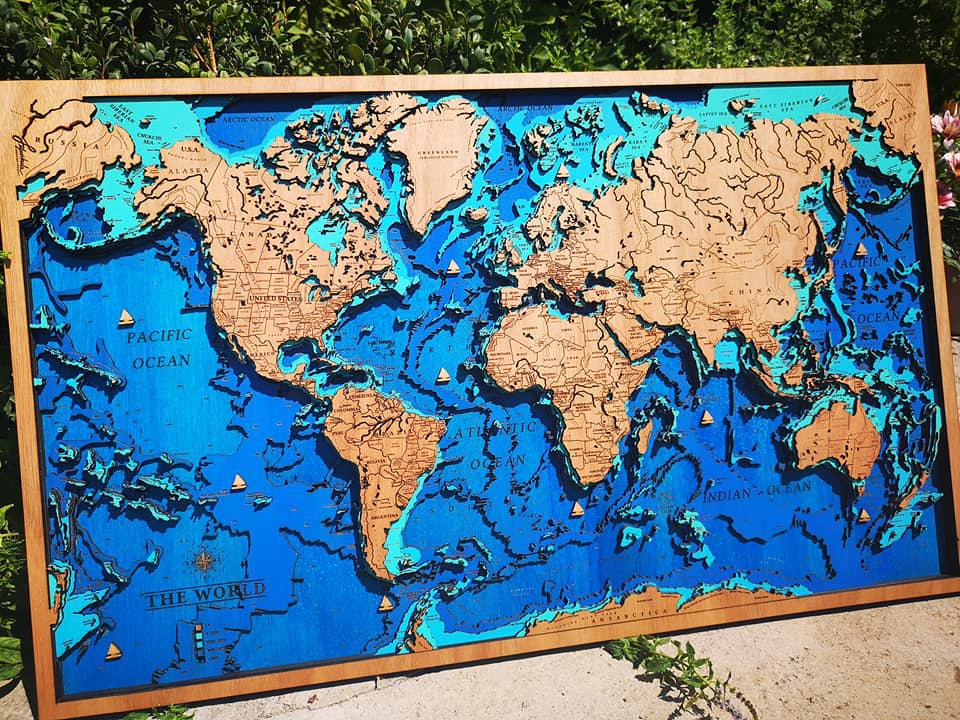
Though a relatively new option for visitors, these 3D maps of Croatia come from a long line of map-making. Maps are one of the oldest things that humans attempted to paint. The earliest archaeological maps include cave paintings and ancient maps of Babylon, Greece, China, and India. However, the earliest known maps are of the stars, not the earth. Images dating to 14,500 BC found on the walls of the Lascaux caves in Dordogne, southwestern France map out part of the night sky, including three stars – Vega, Deneb, and Altair - as well as the Pleiades star cluster. The Cave of El Castillo in Spain holds a wall map dating from 12,000 BC of the Corona Borealis constellation.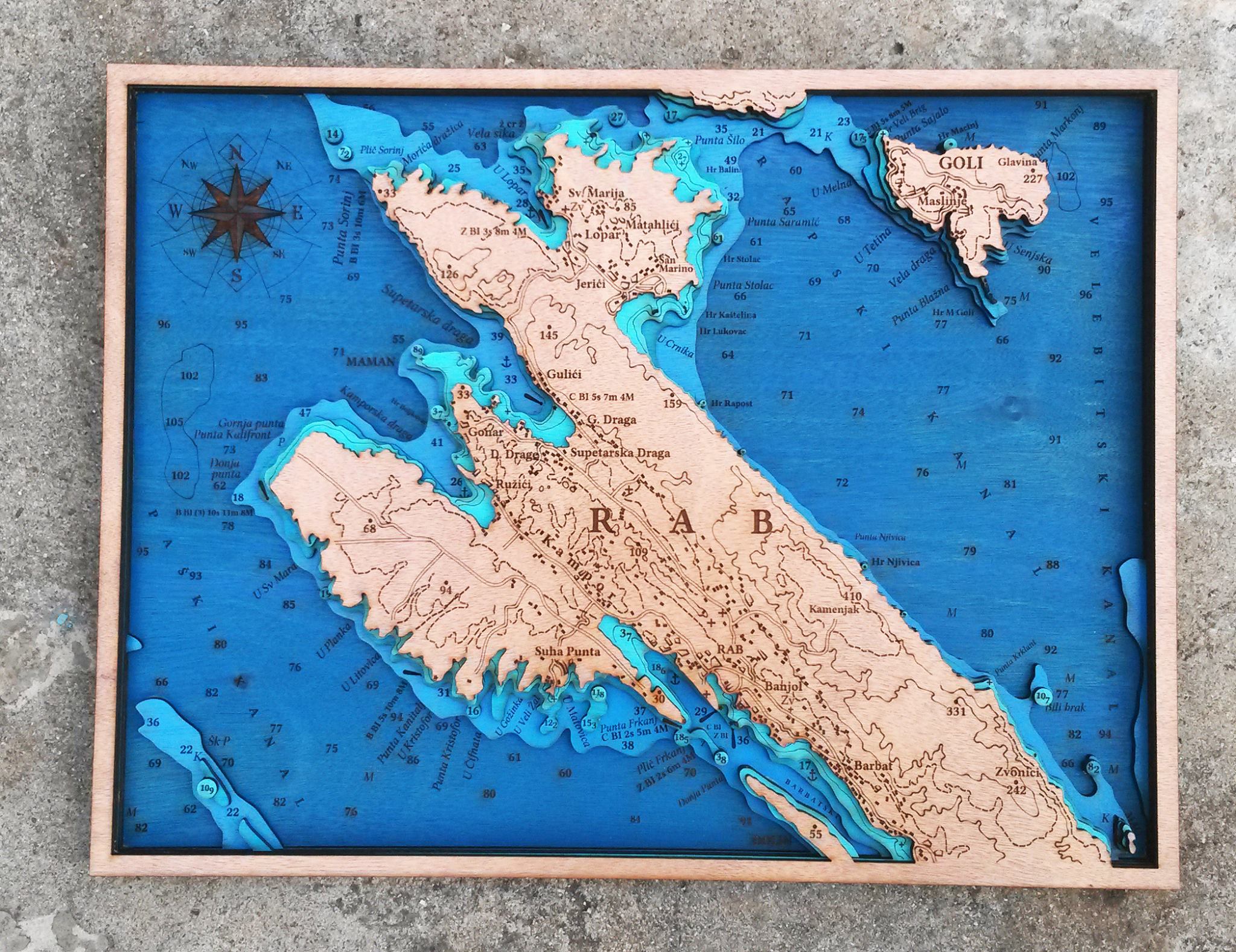
A map-like representation of a mountain, river, valleys, and routes around Pavlov in the Czech Republic, carved on the tusk of a woolly mammoth, has been dated to 25,000 BC, making it possibly the oldest known map of all time. The word map comes from the medieval Latin 'Mappa mundi' with mappa meaning napkin or cloth and mundi meaning the world.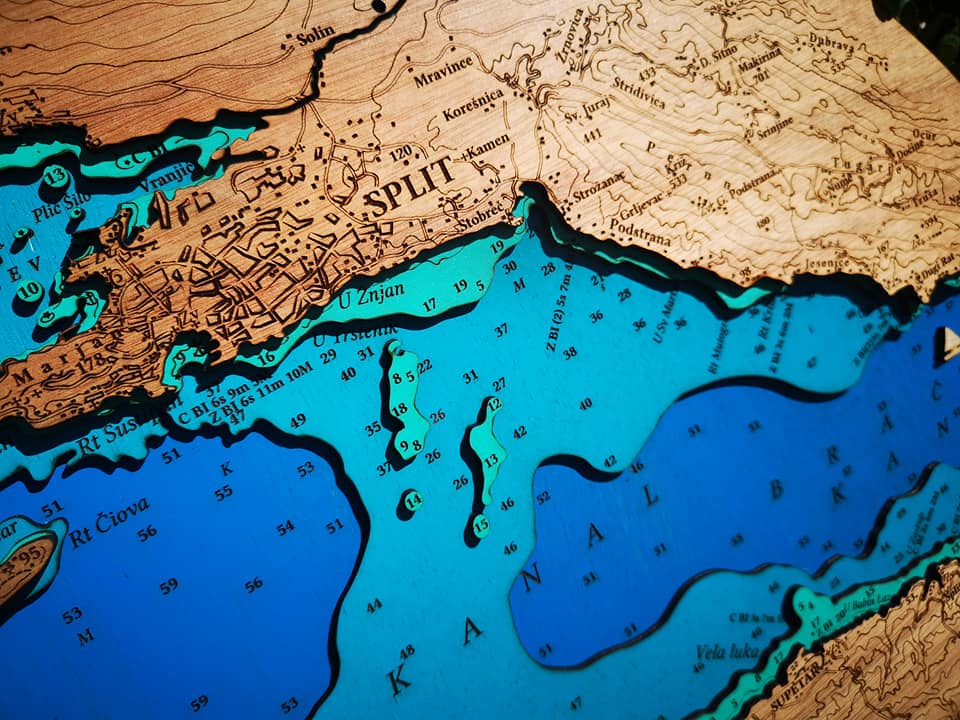
All photos © Fafarikula
For the latest travel info, bookmark our main travel info article, which is updated daily.
Read the Croatian Travel Update in your language - now available in 24 languages
Research from Zadar: Cruise Ship Guests Spend 55 Euro Per Day
February 13, 2020 - Cruise ship guests spend an average of 55 euro a day, and spend most of their money in Solana Nin - or 248 euro, according to a survey by the Tourism and Communication Sciences Department of the University of Zadar. The Department surveyed cruise ship tourists that sailed to Gaženica port in Zadar from July to October 2019.
HRTurizam reports that an interesting fact is that cruise ship guests on the Zadar peninsula spend, on average, 43.27 euro, and in the survey, also mentioned shortcomings whose solution would result in significantly higher consumption. The tourists complained about the insufficient number of exchange offices, the inability to pay by card and euros, and the insufficient number of sellers in stores that can serve a larger group of guests in a short time. Zadar now has an unmistakable indication of what to do to increase cruise ship spending, and can learn a lot from this data.
During their stay on land, respondents spent the most at cafes, on souvenirs and in restaurants, and given during their short stay in the destination, their average personal consumption was relatively high.
It is also interesting that cruisers guests made the most purchases in Solana in Nin, where they spent as much as 248 euro per person on average, which is a result of the fact that they had enough time to make purchases. However, they were also drawn to the attractive offer of Solana, which is adapted to the wishes of tourists.
This interesting research, which was presented in Zadar on Wednesday, was conducted with a semi-structured questionnaire and had the characteristics of a scouting survey. As the authors say, the results outline the profile, behavior and attitudes of cruise tourists included in the sample. A random sample of respondents included 1,315 respondents over the age of 18 who, when disembarking from the Zadar port, visited the old town of Zadar or made some of the excursions offered in Zadar County and other neighboring counties. Just over half of the surveyed visitors visited the Zadar Peninsula, and the most attractive destinations were the Plitvice Lakes and Krka National Parks, the town of Nin and the Zrmanja River.
"The respondents are from Germany, Great Britain and Spain, which is partly conditioned by the established cruise lines that land in the city of Zadar. The respondents are mostly older, which is in line with typical tourists traveling with this kind of transportation. Also, these are mostly experienced cruise passengers who are first-time visitors to Croatia and Zadar, so it can be concluded that they prefer this form of tourist travel and choose routes on which they have not sailed during their cruises so far, said Prof. dr. sc. Bozena Krce Miocic.
Visiting the old town or other tourist locations around Zadar was most often motivated by new experiences and experiences, attractions primarily the Sea Organ and Greetings to the Sun, but also cultural and natural heritage and the desire to feel and experience the atmosphere of the destination.
The overall satisfaction and impression of the surveyed tourists are at a very high level, from which it follows that they would recommend a visited destination to their friends and relatives. Most guests would love to revisit Zadar and other destinations, primarily for enjoying the peace and the preserved environment, gastronomy and cultural heritage. However, despite the positive impression of the cruise tourists surveyed, it should be emphasized that there are still supply elements that need to be continuously improved in order to meet this specific segment of tourist demand, concluded the research authors at the University of Zadar's Department of Tourism and Communication Sciences.
This research is important to consider when 124 cruisers with as many as 182,682 passengers sailed to Gaženica, Zadar's passenger port, which was named the world's best cruise ship last year.
To read more about travel in Croatia, follow TCN's dedicated page.
Zadar's Tourism Leads To Colder Winters, Fewer People
A late-afternoon bura sends a cool gust cutting down Zadar's main thoroughfare, kalelarga. A handful of wanderers and two tourists roam the long, desolate stretch of cobblestone dotted by well-lit stores. Nearly all are empty.
A Yamamay touting fancy undergarments with no one to sell them to. A Swarovski shop’s lonely cashiers stand idly by their registers. A new-ish watering hole called “La Bodega” holds its doors open to reveal empty bar stools.
Cafes, the stoic holdouts in every Croatian town, keep their outdoor seating available for one final warm spell before Christmas.
Welcome to Zadar in its post-summer hibernation, a six-to-eight month period of desolation and doldrums. When infamous “white paper” covers storefronts and obstructs glass-encased restaurants that otherwise resemble aquariums. Go ahead, try to saddle up for a meal somewhere.
That new restaurant you heard offers dynamite cuisine? It’s closed.
How about the old staple of the local scene which has spent decades consistently serving Dalmatian classics? Nope.
Well, at least the fast food joint must… Bupkis.
The few locals left spend the first hours of every morning fervently crossing off grocery lists then trudging off to work. Then home. A brave few remain outside, meandering past now-empty spaces where commerce used to take place.
Cafes remain the lone outliers, open year-round. After all, someone must offer the remaining Zadrani and students a place to congregate and complain about the lack stuff to do.
Thanks to all the hype and bustling summers, Zadar seems to be a Croatian destination on-the-rise. Yet the empty streets tell a more opaque tale.
Zadar's Fervent 'Yes' To Tourists
Like much of Dalmatia, Zadar milked the engorged tourism cow until it backfired in myriad ways.
The historic peninsula at Zadar’s core is hemorrhaging residents, seeing its population plunge by about 25 percent over the last decade. The few remaining make due in the face of living expenses inflated by tourism.
Now, like much of the coast, Zadar is looking for a way out of a boom-bust tourism cycle tied to mother nature’s fluctuations; all while also reversing depressing demographic trends and the growing sense that Zadar is a great place to visit — but not call home.
It’s first attempt: a glitzy new ad campaign featuring robust young folks running, climbing, jumping, all heavily breathing while subjecting themselves to strenuous exercise in scenic locations.
The ad also includes fleeting images of Zadar’s previous target demographic: happy couples taking selfies, families at play, eating dinner, or enjoying a brief respite by the Sea Organ. In the aggregate, those scenes feel drowned out by the sweaty fitness fanatics peppering the ad.
Because Zadar's new target demographic presumably has zero intention of briefly ditching their Fitbit goals during their vacation, nor does it care if the narrator of the promotional video can actually pronounce the town's name.
It ends with a clarion call to “Say yes,” a zealous demand that tourists give all of themselves to enjoying Zadar as it already is.
Say yes? Locals are desperately fighting the urge to say, “No.”
Why The Ghosts Came To Town
Empty storefronts and desolate streets may be a sign of a bigger, more problematic trend: a mass exodus sucking dry the last remnants of a year-round customer base.
“We have high payrolls, electric bills and other expenses, as well as rent,” said Stipe Kneževic, president of the local small business owners association, in an interview with Zadarski List.
Simply put: there aren’t enough locals to spend during the off-season, leading revenues to fall well short of the cost of staying open. For many business owners, it’s smarter to close up shop and minimize losses, then eagerly wait for the hordes to return in late spring. Knežević’s group asked the City of Zadar to lower rents on all municipally owned properties rented out to locals, to no avail.
Other businesses stay open on a shoestring budget, staffed at a bare minimum then seeking capable ringers to fill out staff during the summer.
Good, experienced employees are hard to find, Knezevic added. Many employers end up investing time and energy into training employees, only to have them leave at the end of the year regardless. “Only an idiot would let a good worker leave,” he added.
It all accumulates into a bizarre Catch-22: Zadar’s small businesses close because there’s no one to work or spend money; citizens leave because even if they could make a decent living they don’t have anywhere to spend.
A round table aimed at reviving Zadar’s historic core convened on Wednesday, featuring a gaggle of tourism honchos and local academics.
Zadar’s new tourism director, Mario Paleka, was short on answers at the round table. Many expected to be wow-ed by the same presentation which reportedly landed him the job despite lackluster credentials.
Yet Paleka’s contribution was limited to a few milquetoast promises of big plans and declaring Zadar needed to exist for its citizens — not tourists.
City council member Mladen Malta was the only participant to offer some advice, albeit well-worn, suggesting an increase in available parking, festivities and events need to be spread more evenly throughout the year, and perhaps luring a famous fashion brand to the historic center would all help.
In the end, the group reportedly spent most of their time finding elaborate ways to describe Zadar’s desolation, without listing specific solutions.
Moderator and sociologist Sven Marcelić reportedly claimed a large number of living spaces — perhaps too many — have been rejiggered to accommodate tourists and not locals. The result, after the summer is over, is a high-priced ghost town.
“The number of stores is dropping, and economic activity outside of 'the season’ doesn’t exist,” Marcelić said.
The dearth of accommodations means students studying in Zadar have to pay rents comparable with the pricey tourism season.
“Zadar is fast becoming one of the most expensive cities to study in in Croatia,” Marcelić said. “The growth in private accommodations didn’t follow the increase in tourism, all while citizens turned into second class citizens.”
Finding A Solution
Even Zadar’s new “Say yes” campaign wasn’t universally welcomed. The nearly three-minute opus left some feeling neglected, with officials from the local municipalities of Preko and Ugljan sending an open letter asking why certain parts of the county were wholly ignored.
“Considering the camera’s lens is very expensive, why doesn’t it have a wide angle?” the letter reads. “It apparently doesn’t, since it can’t film the entire county.”
Zadar does have some hope to hang onto — internal bickering and mass emigration not withstanding. Its airport recently crossed the 600,000-passenger threshold this year for the first time ever. Lonely Planet included the town on its 2019 “Best in Travel” list of places to visit — though it ranked second-to-last. (Locals probably weren’t happy to see Serbia’s Novi Sad ranked No. 3).
Some parts of the region are spreading events out, or adding new ones. Pag, an island whose winter offerings are curtailed by its legendary bura, will have its own version of Advent this year to rival Zadar’s own light version of the Zagreb staple.
Yet rejiggering the summer festival schedule and adding more parking barely address the soup-to-nuts problems facing many Zadrani. They’d gladly say yes to the town, region and even Croatia if it offered a stable, fulfilling job with a salary capable of covering ever-growing living expenses.
Until then, "Yes" will be a word Zadar rarely hears from its residents.
Follow the latest on Zadar's tourism, check out TCN's dedicated page here.
Zadar Picks New Tourism Director
Sept. 12, 2018 — Zadar has a new tourism director. He isn’t the most-experienced candidate. He arguably isn’t the most qualified.
He is a member of the Croatian Democratic Union’s local branch, and friends with the mayor.
A Look At Population Growth During Tourist Season
The real figures are even higher if non-commercial accommodation facilities are accounted for, and this year there are nearly half a million beds in 102,000 such facilities.
Zadar Tourism Board Director Ante Rados Ends Tumultuous Tenure
August 1, 2017 — Zadar’s embattled Tourism Board Director Ante Rados resigned, ending a two-year stint marred by criticism from the town’s tourism industry.


